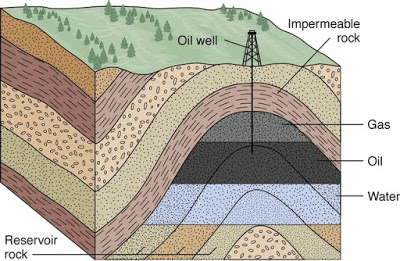Oil and gas reservoir
An oil and gas reservoir is a formation of rock in which oil and natural gas has accumulated. The oil and gas collected in small, connected pore spaces of rock and are trapped within the reservoir by adjacent and overlying, impermeable layers of rock.[1] Typical reservoirs are not "pools" or "lakes" of oil beneath the surface, as there are no vast open cavities that contain oil. Oil and gas reservoirs can also be referred to as "hydrocarbon reservoirs".

Conventional hydrocarbon reservoirs consist of three main parts: the source rock, the reservoir rock, and the cap rock (Figure 1). The source rock is the rock that contains the kerogen that the oil and gas forms from. The reservoir rock is the porous, permeable rock layer or layers that hold the oil and gas. The cap rock seals the top and sides so that the hydrocarbons are trapped in the reservoir, while water often seals the bottom.[3]
For a reservoir to exist, oil and gas from the source rock must migrate into the reservoir rock, which takes millions of years. This migration occurs because oil and gas are less dense than water. This difference in density causes the oil and gas to rise towards the surface so that they are above groundwater with the gas settling above the oil because of its lighter densities. Migration pathways - a set of well connected fractures - must exist for this rising to occur.[4]
Reservoir rocks need to be both porous and permeable. This means that there are small pockets of space within the rock where oil or gas can settle and small channels connecting these pockets to allow the oil or gas to flow out of this rock easily when it is drilled.[4] These spaces between grains can develop as the formation of rock occurs or afterwards, usually as a result of groundwater passing through the rock and dissolving some of the cement between sediment grains.
The rock formation must be formed or deformed in such a way to create a trap for the oil and gas. Anticlines are the most common formation shape for this to occur. Anticlines for a rough "A" shape, with the cap rock making the sides of the "A". The fossil fuels accumulate in the peak of the "A" and the bottom is sealed (usually with water), preventing the oil and gas from seeping out and escaping. [4]
For Further Reading
- Gas
- Oil
- Source rock
- Cap rock
- Oil and gas traps
- Or explore a random page
References
- ↑ ZionOil. (June 5, 2015). Oil Reservoir [Online]. Available: https://www.zionoil.com/updates/oil-formed-part-3-oil-reservoir/
- ↑ Source unknown. Please contact us if you know this image's source.
- ↑ SEED. (June 5, 2015). The Making of Oil [Online]. Available: http://web.archive.org/web/20060427134445/http://www.seed.slb.com/en/scictr/watch/makingoi/birth/birth.htm
- ↑ 4.0 4.1 4.2 Stephen Marshak. (June 5, 2015). Earth: Portrait of a Planet, 3rd ed. New York, NY, U.S.A:W.W. Norton & Company, 2008

